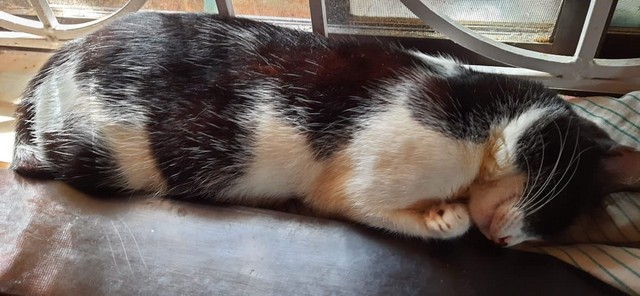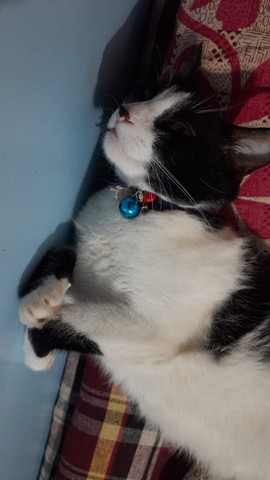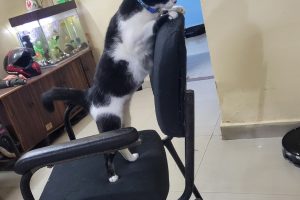Have you ever noticed your cat sleeping and paid close attention to it? I bet you might have noticed its pads stretching or flying in the air, or its whiskers twitching. Or as I have noticed it with my Chingu, when she has those soft meows while sleeping. These are cute escapades that our cats are indulging in, but more than that, these signs are a clear indication that your cat is having a dream.
The science behind how cats dream shows that there is a remarkable similarity between how we humans dream and how cats do it.
The Science Behind Cat Sleep – How do Cats Sleep?
The sleep cycle of cats resembles that of humans and of course, most other mammals. Cats have both non-rapid eye movement (NREM) and rapid eye movement (REM) sleep stages in their sleep just like we humans do.

Of course, cats have a polyphasic sleep cycle, and thus they sleep multiple times a day in batches, instead of a single long nap that we are used to. Each of their naps stretches anywhere between just under 15 minutes to up to 2 hours.
Historic Discovery (1965): French neuroscientist Michel Jouvet’s groundbreaking research with cats proved definitively that animals dream. By removing the pons region of the brainstem, cats began physically acting out their dreams during REM sleep—providing the first concrete evidence of animal dreaming.
Research in the Sleep Foundation indicates that cats sleep for around 12 to 16 hours a day. Some cats may even sleep for over 20 hours. There are several reasons why cats spend such a long time in sleeping. Some of these reasons include energy conservation, memory consolidation, and physical recovery from hunting (something cats retain from their days in the wild).
-
Polyphasic sleepers: Cats sleep in many short intervals, not one long chunk like people.
-
Crepuscular: Cats are most active at dawn and dusk—not nocturnal, as many assume.
-
In one nap, a cat cycles through light sleep (NREM) and deep dream sleep (REM), often waking up alert in between.
The different stages in a cats sleep cycle include
- Light Sleep (NREM Stage 1): Cats remain semi-alert and can easily wake up. This allows them to respond quickly to potential threats, a survival mechanism inherited from their wild ancestors.
- Deep Sleep (NREM Stages 2-3): Characterised by slower brain waves and reduced muscle activity. The body repairs itself and consolidates memories during this stage.
- REM Sleep: The most critical stage for dreaming, occurring within 20 minutes of falling asleep and making up a significant portion of their total sleep time.
The proof that a cat can dream during its sleep came from the research conducted by French neuroscientist Michel Jouvet in the 1960s. His experiments showed that cats have a specific element in their brainstem – known as pons – that causes dreams. It was also concluded that the element stops the cat from physically acting the dream during REM sleep.
When these pons were disabled, cats exhibited the strange behaviour where they acted upon all their dreams, all the while their brain waves indicating that they were in deep sleep. This experiment clearly indicated that cats can dream.
The Physical Signs that Your Cat is Dreaming
So, now that we know cats are capable of dreaming, how can you know that your cat is dreaming? What are the signs to indicate that your cat is dreaming? How to find your cat is dreaming?

Cat owners can easily identify when their pets are dreaming by observing specific physical behaviors during sleep –
Facial Movements
Here are a few facial movements that show your cat is dreaming –
-
Whiskers twitching rapidly
-
Ears flicking or rotating
-
Mouth movements or silent meows
-
Eyes moving behind closed lids
Body movements
In addition to the facial movements, cats may also show a few bodily movements –
-
Paws paddling as if running or hunting
-
Tail swishing or twitching
-
Leg jerks or kicking motions
-
Overall body twitches
Vocalisations
In some special and rare cases, you may find your cat exhibiting vocalisations –
-
Soft meows, chirps, or purring
-
Growling or hissing sounds
-
Chattering noises similar to hunting calls
According to MSD Manual, these movements occur because the brain continues sending motor signals during dreams, but the body’s natural paralysis mechanism prevents full execution of these actions.
-
Cats experience both REM and NREM sleep, just like humans.
-
Dreaming mostly happens during REM sleep, which starts about 20 minutes after falling asleep.
-
Whisker twitching, paw movements, and soft meows are signs your cat is dreaming.
What Do Cats Dream About?
Well, we cannot have access to what cats dream about exactly. But, there are scientific studies that have shed light on what your cat may be dreaming about. Do cats dream like humans? We will find out.
Some of the possible things that cats may be dreaming about include
- Hunting and Predatory Behaviour: The most commonly observed dream behaviour involves stalking, pouncing, and capturing prey. Cats may dream about chasing mice, birds, or toy prey they’ve encountered during waking hours.
- Daily Experiences: Like humans, cats likely process their daily activities through dreams. This might include interactions with family members, exploring their territory, or engaging in play.
- Social Interactions: Cats may dream about encounters with other cats, their human companions, or even conflicts they’ve experienced.
- Environmental Navigation: Dreams might involve familiar spaces like favorite sleeping spots, climbing areas, or outdoor territories they’ve explored.
Do Cats Have Nightmares?
Just the other day, I witnessed something strange with our pet cat, Chingu. She was having a sound sleep just beside me on her favourite chair. All of a sudden, out of nowhere, she leapt out of her sleep, and stared at me with a startled look. It was obvious that she was frightened. She kept crying for a while until she became normal after a while. Obviously, she had a bad dream.
Just as cats can have pleasant dreams, evidence suggests they can also experience nightmares or disturbing dreams.
Signs that a cat may be having a nightmare include
-
More intense or agitated movements during sleep
-
Distressed vocalizations like growling or fearful meows
-
Waking up suddenly and appearing frightened or disoriented
-
Defensive postures immediately upon waking
Not every cat experiences nightmares. Even when they do, it might have something to do with what happened during the day and recent times. However, cats that have gone through trauma are more likely to experience nightmares quite frequently. This behaviour is observed to be much prevalent in rescue cats or those who lived as strays.
Sleep and Dream Patterns in Cats as Per Age
As cats age, their sleep patterns and dreaming behaviors change significantly
Kittens (0-6 months):
-
Sleep up to 20 hours per day
-
Experience more REM sleep and dreaming
-
Show more frequent twitching and movement during sleep
-
Need extensive sleep for neurological development
Adult Cats (1-7 years):
-
Sleep 12-16 hours per day
-
Balanced REM and NREM sleep cycles
-
Moderate dreaming activity
-
Efficient sleep-wake transitions
Senior Cats (7+ years):
-
May sleep more hours but with less efficient REM sleep
-
Reduced dreaming frequency
-
More frequent brief awakenings
-
Potential sleep disorders related to cognitive changes
Sleep and Dream Disorders to Look for in Cats
| Normal Dream Signs | Concerning Sleep Disorder Signs | Action Required |
|---|---|---|
| Brief whisker twitching | Seizure-like movements >10 seconds | Veterinary consultation |
| Soft paw paddling | Loss of bladder/bowel control | Immediate vet visit |
| Quiet vocalizations | Violent thrashing | Emergency care |
| Easy awakening | Inability to wake cat | Medical evaluation |
A slight twitching and bodily movement during sleeping or dreaming may be normal and harmless. However, excessive or concerning behaviours may need to be addressed by a veterinarian. REM Sleep Behaviour Disorder (RBD) can occur in cats when the natural muscle paralysis fails, leading to violent or excessive dream enactment.
Some of the warning signs that you should specifically pay attention to include
-
Seizure-like rigid movements lasting more than a few seconds
-
Loss of bladder or bowel control during sleep
-
Inability to wake the cat during episodes
-
Confusion or aggression immediately upon waking
-
Excessive vocalisation that seems distressed
Conclusion
The science behind how cats dream lets us know the complexity of sleep psychology in cats. Based on several studies, we today know that cats experience rich, vivid dreams primarily during REM sleep, likely processing their daily experiences, hunting instincts, and social interactions.
The next time you observe your cat’s whiskers twitching or paws paddling during sleep, you’re witnessing the fascinating phenomenon of feline dreaming—a window into their inner world that connects them to the broader mammalian experience of sleep and consciousness. This understanding not only deepens our appreciation for our feline companions but also highlights the importance of providing them with environments that support healthy, restorative sleep and the dreams that come with it.




Add Comment